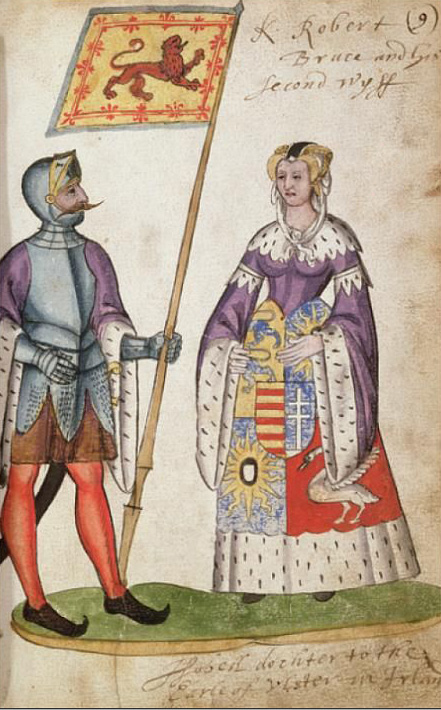Elizabeth de Burgh - Queen Consort of Scots
Alas, we are but King and Queen of the May!
Elizabeth de Burgh was the second wife of Robert the Bruce, King of Scots. She was the daughter of the formidable Richard Óg de Burgh, the Red Earl and Lord of Ulster, and his wife, Margarite de Burgh. Elizabeth was also a god-daughter of Edward I of England.

Elizabeth was born sometime around 1289 in what is now County Antrim in Ulster, Northern Ireland. Her father, Richard, was a close friend and ally of King Edward I.
Elizabeth likely met Robert the Bruce, then Earl of Carrick, at the English court. In 1302, Elizabeth and Robert were married in Writtle, near Chelmsford in Essex, England. Elizabeth was about 13, and Robert was 28 when they married. Robert's first wife, Isabella of Mar, died six years earlier, giving birth to their daughter, Marjorie Bruce.
On March 27th, 1306, Robert and Elizabeth were crowned King and Queen of Scots at Scone. The coronation occurred in defiance of the English claims of suzerainty after Edward I stripped the Scottish crown from John de Baliol. Assuming retribution from Edward I, Elizabeth was quoted as saying:
"Alas, we are but the King and Queen of the May!"

Less than three months later, on June 19th, 1306, the Scots were defeated at the Battle of Methven by the English under Aymer de Valence, and Robert sent Elizabeth, his daughter Marjorie, and his two sisters to Kildrummy Castle in Aberdeenshire, which was under the protection of his brother Neil de Brus.
The English laid siege to Kildrummy Castle and eventually succeeded after bribing a blacksmith to set fire to the grain store. Neil de Brus was hanged, drawn, and quartered along with other men in the castle. However, the ladies had already fled the castle with the help of the 9th Earl of Atholl.
They found refuge at the sanctuary of St. Duthac in Tain but were betrayed when the Earl of Ross, a supporter of the Comyns, dispatched them to King Edward at Lanercost Priory. Edward sent the Bruce's sisters to Berwick Castle and Roxburgh Castle, where they were placed in wooden cages on the castle walls. The Bruce's daughter, Marjorie, was sent to the nunnery at Watton. Elizabeth was held under conditions of house arrest in England, as Edward still needed the support of her father, Richard. The Earl of Atholl was hanged, and his head was displayed on London Bridge as a warning to others supporting Robert the Bruce.
Elizabeth was a prisoner of the English for eight years, being held at Burstwick-in-Holderness in Yorkshire before being transferred to Bisham Manor in Berkshire. From there, she was moved to Windsor Castle, where she had six attendants and an allowance. In 1312, she was transferred to Shaftesbury Abbey in Dorset, Barking Abbey in Essex, and Rochester Castle in Kent.
After the Battle of Bannockburn, in which the Scots defeated the English, she was moved to York while prisoner exchange talks took place. While at York, she had an audience with King Edward II of England. In 1315, she was released as part of the ransom for the Earl of Hereford, Humphrey de Bohun, who the Scots had captured at Bannockburn.
Besides becoming Marjorie's stepmother after marrying Robert, Elizabeth and Robert would have four children: Matilda, Margaret, David, and John. David would become King David II of Scotland after his father's death.
On October 27th, 1327, Elizabeth died at the royal residence at Cullen in Banffshire, Scotland, possibly due to complications in childbirth to her son John, who was born that same year. Plans were made to transport her body to Dunfermline Abbey in Fife. Out of concern that her remains would not arrive intact, steps were taken to have her organs removed during the embalming.
In gratitude, Robert the Bruce decreed that a chaplaincy be established at the Auld Kirk of Cullen and five pounds be paid in perpetuity to have Masses said for the soul of Elizabeth.
Robert the Bruce would die 18 months later, in 1329, and his body was laid to rest beside Elizabeth in the center of the abbey beneath the high altar of Dunfermline Abbey.
